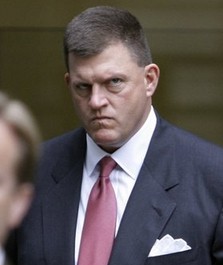NBA commissioner Adam Silver said at a news conference in New York on Monday that the league’s new nine-year TV deal  with ESPN and Turner “will have a profound effect” on the salary cap.
with ESPN and Turner “will have a profound effect” on the salary cap.
By any measure, the new deal is a doozy. In years, it is the longest ever signed by the league, one year longer than the current deal. In money, it is $24 billion total and an average of $2.67 billion per season, nearly triple the $925 million average of the current deal, which expires after the 2015-16 season.
“When this deal kicks in in 2016-17, it will lead to a substantial increase that year in the salary cap,” Silver said.
How substantial? The current cap is at $63 million. According to one report, it could jump to over $80 million in the first year of this deal. Another report said it could skyrocket to more than $91 million.
Or put it this way: At that second figure, the salary floor – 90 percent of the cap – would be roughly $5 million higher than the current luxury tax threshold.
It is important to keep in mind that many of these figures are arrived at using estimates and projections. But even the most pessimistic accountant in the world would agree that NBA owners are in for a financial windfall of historic proportions.
Silver said that he has already had conversations with new NBA Players Association executive director Michele Roberts about the union’s desire to gradually add some of the anticipated revenue of the new deal to the current deal so there is not a dramatic one-year leap in the salary cap.
Remember, when the salary cap increases, so does everything else; maximum salaries and the mid-level, bi-annual and room exceptions all are generated as a percentage of the salary cap. The rookie scale is more dependent upon previous salaries but would also see a boost from the new TV deal.
 “We have a meeting later this afternoon to gauge their interest in creating a smoothing effect,” Silver said. “I mean they will get their 51 percent (of basketball-related income) no matter what, it’s just a question of how it comes in in terms of the cap. It will have a profound effect and I’m sure the union has already begun studying it just as we have been studying how it will affect our system team by team.”
“We have a meeting later this afternoon to gauge their interest in creating a smoothing effect,” Silver said. “I mean they will get their 51 percent (of basketball-related income) no matter what, it’s just a question of how it comes in in terms of the cap. It will have a profound effect and I’m sure the union has already begun studying it just as we have been studying how it will affect our system team by team.”
Here’s how it will affect Silver’s system: Not a single team will be able to cry poor any longer. Not one. Not the Brooklyn Nets and their $94 million payroll. Not the Oklahoma City Thunder and their steadfast refusal to pay the luxury tax. Not the Milwaukee Bucks and their desire for public funds to help build a new arena.
Remember, this was the tearful ballad of owners leading up to the last lockout in 2011, as they sang backup vocals to lead singer David Stern. They argued that the BRI split giving 58 percent to the players was untenable and that most teams were losing money. They held fast to their principles and exacted more than a pound of flesh from a union with dysfunctional leadership, knocking the BRI down to nearly a 50-50 split, shortening contract lengths and gaining the stretch provision.
But things have changed a lot in less than three years. The salary cap jumped nearly $5 million this summer, practically matching the increase from the previous nine years combined. The Bucks, a small market team with no identity on the national landscape, sold for a record $550 million. That record was obliterated when the Los Angeles Clippers, a big market team with plenty of identity on the national landscape, sold for a staggering $2 billion. Any NBA owner crying poor right now can wipe his eyes with a hundred-dollar bill.
Silver answered smartly and deftly avoided sounding like Scrooge McDuck when asked about the impact of the new TV deal on the next collective bargaining agreement.
“From a financial standpoint for the league, obviously the implications are very positive to have this additional money coming in,” he said. “In terms of its impact on the CBA, our current deal provides that players receive roughly 50 to 51 percent off the top. So a lion’s share of this money will be paid directly to the players, so I think it bodes well.”
Unfortunately, not everyone is as silver-tongued as Silver. Sharing the dais was Washington Wizards owner Ted Leonsis,  who chairs the NBA’s Media Committee and somehow tried to make his share of $24 billion sound like finding a rumpled twenty in an old jacket.
who chairs the NBA’s Media Committee and somehow tried to make his share of $24 billion sound like finding a rumpled twenty in an old jacket.
“There’s so much that goes into profitability outside of what the players get paid,” Leonsis said. “Your building deal, your lease, what kind of debt do you have on the team and the like.”
For the record, Leonsis had a microphone in his hands, so he couldn’t rub his palms together while he was talking.
None of this will be lost on Roberts, who may be new to her job but is no dummy. All of the recent visible metrics point to the NBA enjoying a financial renaissance despite incremental growth in our nation’s economy and battling other supposedly more popular sports for the public’s limited disposable income and viewing time. But the truth is that the NBA does not have the image problems currently troubling the NFL or the star recognition issues hampering Major League Baseball.
Both the players and owners have the ability to opt out of the current CBA after the 2016-17 season, which is the first year of the new TV deal. You can be sure that the union will opt out and be looking to regain a bigger slice of the pie from owners who, when discussing finances over the last five years, now appear to have been somewhere between hyperbolic and disingenuous.
Awesome blog! Do you have any recommendations for aspiring writers?
I’m hoping to start my own blog soon but I’m a little
lost on everything. Would you advise starting with a free platform like WordPress or
go for a paid option? There are so many choices out there that I’m
completely overwhelmed .. Any ideas? Appreciate it!